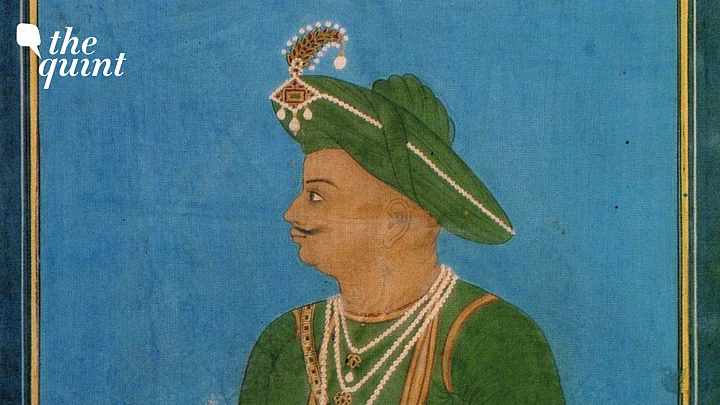It’s not new for politicians to evoke historical figures to ride on their legacy today. However, what’s not so common is the creation of fictional characters to gain political mileage.
In Karnataka, the Bharatiya Janata Party (BJP) has been using Tipu Sultan, the 18th-century ruler of the erstwhile Mysuru Kingdom, to pit him against Hindutva ideologue VD Savarkar, Maratha ruler Chhatrapati Shivaji and even Hindu Gods – Lord Ram and Lord Hanuman.
And if that was not enough, two new characters – Uri Gowda and Nanje Gowda – have been introduced into the poll campaign as Vokkaliga chieftains, who apparently killed the 18th-century-ruler, instead of the well-documented fact of Tipu Sultan being killed by the British in the fourth Anglo-Mysore war in 1799.
So, who are Uri and Nanje Gowda? Did they exist? Why is the BJP using them now? What do historians have to say? We answer.
Who Are Uri and Nanje Gowda?
The first mention of these two characters - Vokkaliga chieftains - came up in the 2022 play titled ‘Tippu Nija Kanasugalu,’ which translates to ‘The Real Dreams of Tipu,’ written by the former Director of the cultural institute Rangayana, Addanda Cariappa.
This play was written as opposed to the 1997 play ‘Tipu Sultan Kanda Kanasu’ (The Dream of Tipu Sultan), written by the famous Girish Karnad, who based it on the Farsi manuscript written by Tipu Sultan himself, documenting his dreams from 1785 to 1799 (a year before he was killed).
Cariappa’s play was staged at Bhoomigeeta in Mysuru in November 2022 and a book was also published with the same story. He claimed that his play showed the "true character" of the 18th-century ruler.
The publishing of Cariappa’s book was followed by a writ petition filed in a Karnataka court by BS Rafiulla, the former Chairman of the District Wakf Board Committee, seeking a stay on the play and the book alleging that it hurt the feelings of the Muslim community and moreover "contains wrong information without any support or justification from history.”
The Additional City Civil and Sessions court then granted an interim stay on the distribution and sale of the book. The play however was allowed to be staged.
On 19 March, the play concluded its 50th performance.
Now, historians believe these characters are 'part of the right-wing’s imagination,' and brought to the fore by the ruling party, the BJP.
How Has BJP Carried the Narrative Forward?
Prime Minister Narendra Modi visited poll-bound Karnataka on 12 March to inaugurate the Mysuru-Bengaluru highway.
Ahead of his visit, four arches were erected on the route. Three of the four arches were named after Kempe Gowda, Krishnaraja Wodeyar, and Sir M Visvesvaraya – all historical figures.
The fourth arch, however, had the names of Uri Gowda and Nanje Gowda. After locals in Mandya and leaders of the Congress party objected, the arch was removed and replaced overnight with that of Vokkaliga pontiff Sri Balagangadharanatha Swamiji.
A month after the court stayed the sale of the book, BJP leader CT Ravi had claimed in Mandya that Uri and Nanje Gowda had contributed to the development of the Mysuru region, not Tipu Sultan.
In February this year, Karnataka Higher Education Minister CN Ashwath Narayan, while addressing a rally in Mandya, said that “Vokkaliga chieftains Uri Gowda and Nanje Gowda finished off Tipu Sultan,” and the same way, the Vokkaliga voters of the district should “finish off” Siddaramaiah. The statement raked up controversy and triggered an apology by the minister.
The Vokkaligas have not been happy about the use of the two characters. Prominent Vokkaliga seer Nirmalananda Swamy has urged BJP leaders from the community to “remain silent over the issue."
Moreover, BJP minister and producer Munirathna, who recently announced that his studio would be releasing a movie titled “Uri Gowda Nanje Gowda,” has also withdrawn the project after meeting Nirmalananda Swamy at the Adichunchanagiri mutt in Mandya.
But Did the Two Characters Exist?
Speaking to The Quint, Professor NV Narasimhaiah, a veteran historian who specialises in the history of the Mysuru Kingdom, said, “This is 100 percent fake. Tipu Sultan was killed by the British on 4 May 1799 at Srirangapatna. Mir Sadiq, who was Tipu’s Finance Minister, betrayed him after forming a nexus with the British – particularly Governor General of the British army, Wellesley, and with the Marathas and the Nizam of Hyderabad.”
Stating that there is no archival evidence to suggest their existence, cultural theorist and author N Manu Chakravarthy, told The Quint, that this “argument will lead us nowhere.”
He added that the ruling party is using this “technique” on the three following levels:
Since Old Mysuru is fond of the Wodeyar family, this will draw sympathy towards the Wodeyars.
Create a shift which will polarise the Vokkaliga and the Lingayats.
Whip up anti-Muslim sentiment.
The first level, Chakravarthy added:
“Will augment their communal tendencies and turn people against Muslims. This is deadly communalism and not ignorant or innocent creationism. How is it that this is coming up now? And it is Ashwath Narayan – a Vokkaliga – who is propagating this.”
Despite their “technique”, the author believes that it “will not create a divide between Vokkaligas and Muslims.”
Speaking on the writer of the play, Cariappa, Chakravarthy said, "Where did he get his material from? For him to come up with it is to appease these people (the ruling party)."
Chakravarthy, who is from Mysuru himself, said, "When I was growing up, everybody saw Tipu as the tiger of Mysore, as Mysore huli. It was part of the folklore and it was not so just for the Muslim community."
With the Karnataka Assembly elections inching closer, the BJP is trying to make inroads into the Old Mysuru region, which has 61 Assembly seats, and a large number of Vokkaliga voters.
The narrative of piting Uri and Nanje Gowda against Tipu Sultan should be seen in the context of the BJP having had minimal electoral success in the region.
